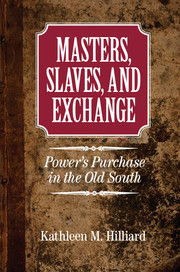2 - Slaves and Spending
Published online by Cambridge University Press: 05 June 2014
Summary
One Saturday night in May 1851, a group of slaves gathered in a cabin on Simpson’s plantation in Anderson District, South Carolina. Eager to earn some extra cash, Joe planned to steal, then sell, a few turkeys from James Gray’s farm and tried to enlist his fellow slaves to go along with him. Despite concerns by Leah and Henry that the would-be thieves would “get into a scrape,” Sam agreed to join Joe in the heist. As they watched the two men slip into the woods, Henry turned to Leah and asked, “Joe loves money don’t he?”
Why wouldn’t Joe love money? Having property and cash presented Joe with opportunities ostensibly denied to slaves of the antebellum South. He could purchase food and tobacco as supplement to weekly rations, drink and gamble, or participate in a wider consumer market, purchasing manufactured goods such as hats, dresses, umbrellas, and watches. Joe may have even derived a sense of empowerment from the jingle of silver in his pocket and the sight and feel of banknotes held securely in his own pocketbook. Leah, however, interpreted the situation differently. In response to Henry’s assessment of Joe, she commented, “Joe is like the rest ... but that he was not to be depended on.” Even though Leah probably had benefited materially from the availability of cash among her fellows, her remark reveals a mindful ambivalence toward the role of the market and the availability of cash within the slave community. Perhaps she was wary of temptations and tensions that market activity could engender or, maybe, Joe’s desire for money served as an all too stark reminder of her master’s own avarice, a characteristic that could only find fulfillment through the exploitation of the labor of, or equity in, her and her family.
- Type
- Chapter
- Information
- Masters, Slaves, and ExchangePower's Purchase in the Old South, pp. 46 - 68Publisher: Cambridge University PressPrint publication year: 2013



